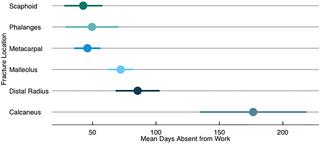Our official English website, www.x-mol.net, welcomes your feedback! (Note: you will need to create a separate account there.)
The socioeconomic impact of orthopaedic trauma: A systematic review and meta-analysis.
PLOS ONE ( IF 3.7 ) Pub Date : 2020-01-15 , DOI: 10.1371/journal.pone.0227907 Nathan N O'Hara 1, 2 , Marckenley Isaac 1 , Gerard P Slobogean 1 , Niek S Klazinga 2
PLOS ONE ( IF 3.7 ) Pub Date : 2020-01-15 , DOI: 10.1371/journal.pone.0227907 Nathan N O'Hara 1, 2 , Marckenley Isaac 1 , Gerard P Slobogean 1 , Niek S Klazinga 2
Affiliation

|
The overall objective of this study was to determine the patient-level socioeconomic impact resulting from orthopaedic trauma in the available literature. The MEDLINE, Embase, and Scopus databases were searched in December 2019. Studies were eligible for inclusion if more than 75% of the study population sustained an appendicular fracture due to an acute trauma, the mean age was 18 through 65 years, and the study included a socioeconomic outcome, defined as a measure of income, employment status, or educational status. Two independent reviewers performed data extraction and quality assessment. Pooled estimates of the socioeconomic outcome measures were calculated using random-effects models with inverse variance weighting. Two-hundred-five studies met the eligibility criteria. These studies utilized five different socioeconomic outcomes, including return to work (n = 119), absenteeism days from work (n = 104), productivity loss (n = 11), income loss (n = 11), and new unemployment (n = 10). Pooled estimates for return to work remained relatively consistent across the 6-, 12-, and 24-month timepoint estimates of 58.7%, 67.7%, and 60.9%, respectively. The pooled estimate for mean days absent from work was 102.3 days (95% CI: 94.8-109.8). Thirteen-percent had lost employment at one-year post-injury (95% CI: 4.8-30.7). Tremendous heterogeneity (I2>89%) was observed for all pooled socioeconomic outcomes. These results suggest that orthopaedic injury can have a substantial impact on the patient's socioeconomic well-being, which may negatively affect a person's psychological wellbeing and happiness. However, socioeconomic recovery following injury can be very nuanced, and using only a single socioeconomic outcome yields inherent bias. Informative and accurate socioeconomic outcome assessment requires a multifaceted approach and further standardization.
中文翻译:

骨伤的社会经济影响:系统评价和荟萃分析。
这项研究的总体目标是确定在现有文献中骨科创伤对患者的社会经济影响。MEDLINE,Embase和Scopus数据库于2019年12月进行了搜索。如果超过75%的研究人群由于急性创伤而遭受阑尾骨折,平均年龄为18至65岁,则该研究符合纳入条件。包括社会经济成果,定义为收入,就业状况或教育状况的量度。两名独立的审阅者进行了数据提取和质量评估。使用带有反方差加权的随机效应模型计算社会经济成果测度的汇总估计。255项研究符合资格标准。这些研究利用了五种不同的社会经济成果,包括重返工作(n = 119),缺勤天数(n = 104),生产力损失(n = 11),收入损失(n = 11)和新失业(n = 10)。在6、12和24个月的时间点估计值中,分别为58.7%,67.7%和60.9%的汇总估计值保持相对一致。缺勤平均天数的汇总估算为102.3天(95%CI:94.8-109.8)。受伤一年后有13%的人失业(95%CI:4.8-30.7)。在所有汇总的社会经济成果中均观察到巨大的异质性(I2> 89%)。这些结果表明,骨科损伤会对患者的社会经济福祉产生重大影响,这可能会对一个人的心理福祉和幸福产生负面影响。但是,受伤后的社会经济复苏可能非常微妙,而仅使用单一的社会经济结果会产生固有的偏见。准确而准确的社会经济成果评估需要采取多方面的方法并进一步标准化。
更新日期:2020-01-16
中文翻译:

骨伤的社会经济影响:系统评价和荟萃分析。
这项研究的总体目标是确定在现有文献中骨科创伤对患者的社会经济影响。MEDLINE,Embase和Scopus数据库于2019年12月进行了搜索。如果超过75%的研究人群由于急性创伤而遭受阑尾骨折,平均年龄为18至65岁,则该研究符合纳入条件。包括社会经济成果,定义为收入,就业状况或教育状况的量度。两名独立的审阅者进行了数据提取和质量评估。使用带有反方差加权的随机效应模型计算社会经济成果测度的汇总估计。255项研究符合资格标准。这些研究利用了五种不同的社会经济成果,包括重返工作(n = 119),缺勤天数(n = 104),生产力损失(n = 11),收入损失(n = 11)和新失业(n = 10)。在6、12和24个月的时间点估计值中,分别为58.7%,67.7%和60.9%的汇总估计值保持相对一致。缺勤平均天数的汇总估算为102.3天(95%CI:94.8-109.8)。受伤一年后有13%的人失业(95%CI:4.8-30.7)。在所有汇总的社会经济成果中均观察到巨大的异质性(I2> 89%)。这些结果表明,骨科损伤会对患者的社会经济福祉产生重大影响,这可能会对一个人的心理福祉和幸福产生负面影响。但是,受伤后的社会经济复苏可能非常微妙,而仅使用单一的社会经济结果会产生固有的偏见。准确而准确的社会经济成果评估需要采取多方面的方法并进一步标准化。



























 京公网安备 11010802027423号
京公网安备 11010802027423号